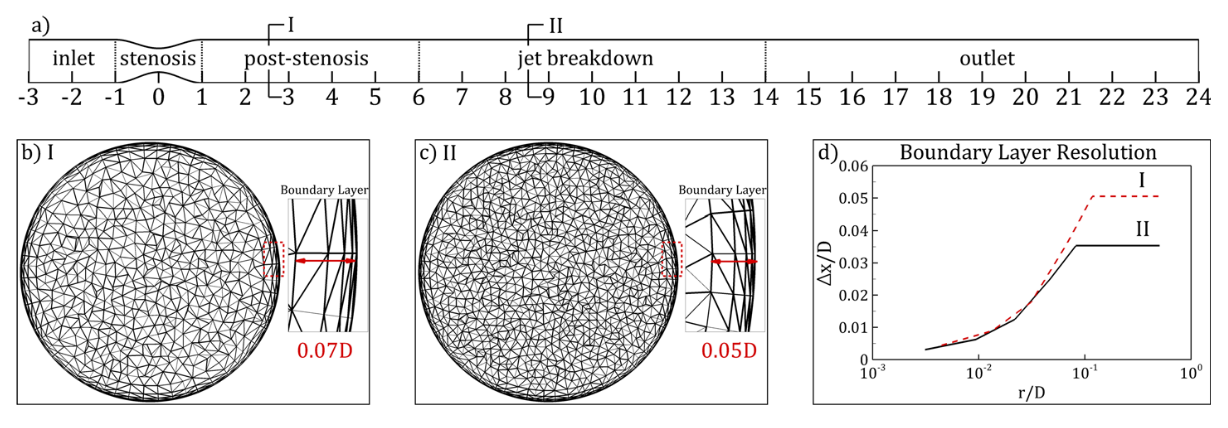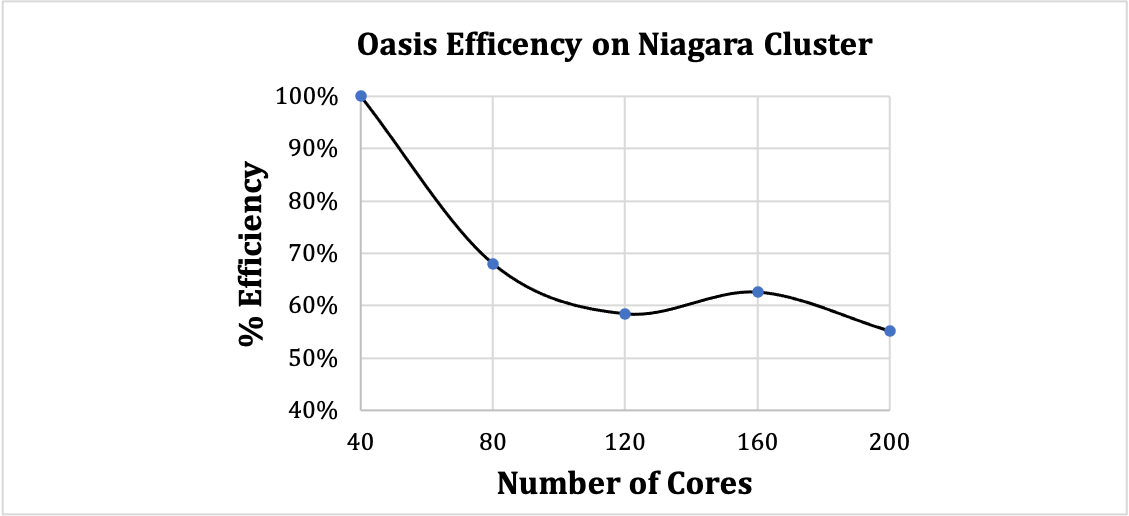Table of Contents
- Introduction to Oasis Tools
- Scaling of Oasis on Niagara
- Niagara Script for Oasis
- Convert Simvascular Mesh to Oasis Mesh
- Convert Simvascular Velocity to Oasis Velocity
- Simulate Advection-Diffusion Equation using Pre-computed Velocity
Introduction
The scripts in this repository provide useful tools to facilitate CFD simulations using the Oasis solver (https://github.com/mikaem/Oasis). You will need the following libraries to use these tools:
- vtk
- Fenics
If you have a mac, I recommend installing VTK first and then Fenics using the following commands:
foo@bar:~$ conda create -n Fenics
foo@bar:~$ conda activate Fenics
foo@bar:~$ conda install vtk
foo@bar:~$ conda install -c conda-forge fenicsTo get help for any script, please type:
foo@bar:~$ python [ScriptName.py] -hScaling of Oasis CFD Solver on Niagara Computing Cluster
Oasis is a high-performance CFD solver that has shown accuracy on par with state-of-the-art DNS solvers (e.g., NEK5000). Oasis is a minimally-dissipative and energy-preserving solver, ideal for high-resolutions simulations of transitional or turbulent blood flows in the cardiovascular system.
Cluster Specification
Below, we have demonstrated the scaling of Oasis solver on SciNet's Niagara Compute Cluster. Each node on Niagara cluster has 40 Intel "Skylake" cores at 2.4 GHz and 88 GiB / 202 GB RAM per node.
Test Problem
The scaling test was performed on an eccentric stenosis problem at Reynolds number of 1600, typical of those observed in the aorta at Peak Systole (see Khan et al., FTaC, 2018). The geometry and the mesh information is shown in the Figure 1. The model has a 5% eccentricity at the throat of the stenosis that acts as a geometric perturbation to destabalize the flow towards turbulence. The CFD simulations were run with 2.6 million tetrahedral elements, with P2-P1 polynomial functions for velocity and pressure, which resulted in an effective mesh size of ~21 million elements. The Reynolds number was 1500 with a temporal resolution of 0.0005 seconds.
 Figure1: Cross-sectional view of the tetrahedral mesh used in the study. a) Schematic of the stenosis model with the region of local refinement, 6D ≤ x ≤ 14D, marked with dashed line. I and II correspond to cut locations. b) and c) Cross-sectional cut of the mesh outside (i.e. I) and within (i.e. II) the region of local refinement, respectively. The inset shows boundary layer elements close to the wall. d) Plot of boundary layer resolution for cross-sectional cuts I (dashed line) and II (solid line).
Figure1: Cross-sectional view of the tetrahedral mesh used in the study. a) Schematic of the stenosis model with the region of local refinement, 6D ≤ x ≤ 14D, marked with dashed line. I and II correspond to cut locations. b) and c) Cross-sectional cut of the mesh outside (i.e. I) and within (i.e. II) the region of local refinement, respectively. The inset shows boundary layer elements close to the wall. d) Plot of boundary layer resolution for cross-sectional cuts I (dashed line) and II (solid line).
Scaling Results
Simulations were run at 40, 80, 120, 160, 200 cores, corresponding to 1, 2, 3, 4 and 5 nodes on the Niagara computing cluster. % Efficiency was computed relative to 40 core. As seen in Figure 2, Oasis scaling drops to 70% at 2 nodes (i.e., 80 cores) and then lingers around 60% at >= 3-5 nodes. Hence, the optimal performance can be obtained at 1 Node (40 cores). However, if further speed gain is required, 2 Nodes may provide a balance between speed and efficiency.
 Figure 2: Scaling test of Oasis on Niagara Compute Cluster with a stenotic mesh of 2.6 million elements run with P2-P1 polynomial function
Figure 2: Scaling test of Oasis on Niagara Compute Cluster with a stenotic mesh of 2.6 million elements run with P2-P1 polynomial function
%-----------------------------------------------------------
SciNet Computing Cluster (Niagara) Script to Run Oasis
Niagara_Oasis.sh can be used to load specific modules and run Oasis on Niagara. Please ensure to modify this script as necessary. Specifically, change the following parameters in the script.
#SBATCH --time=01:00:00: The maximum allocated time to requested. Maximum allowed is 1 day.
#SBATCH --nodes=1: The number of nodes requested. Usually 1 or 2 are sufficient.
#SBATCH --mail-user=youremailaddress@torontomu.ca: You can provide an email address to be notified when your SciNet job starts or finishes.
mesh_path: Path to where you have stored the mesh.
Convert SimVascular Mesh to Oasis readable Mesh
SimVascular software (see simvascular.github.io) can be used to segment and generate volumetric meshes. SimVascular produces a folder called "mesh-complete", which contains the volumetric, wall and cap meshes. Prior to generating the mesh in SimVascular, please ensure that the inflow cap is labelled as "inflow".
The following script can be used to produce a VTU file that can be visualized in Paraview and .xml.gz file that can be read into Oasis CFD solver. Here is how to use the script.
foo@bar:~$ python OasisMeshWriterForSimVascular.py -InputFolder /path/to/mesh-complete/ You may define the following parameters: The script will output two files in the same folder as the /path/to/ (i.e. where mesh-complete folder is located).
- mesh-complete.vtu: A volumetric mesh file that can be read into paraview along with all of the boundary ids.
- mesh-complete.xml.gz: A volumetric msh file that can be read into Oasis. Please refer to VaMPY documentation (https://github.com/KVSlab/VaMPy) on how to conduct simulations with the Oasis CFD solver.
Note: The CellEntityIds tag in the mesh correspond to: 0=volumetric mesh, 1=wall mesh, 2=inflow and 3...N for outflows.
Note: The VTU file is converted in .xml.gz file using the vmtkMeshWriter script. However, the conda installing of vmtk will give you an error. You will need to update the vmtkMeshWriter script manually to corrct this. Please open the vmtkmeshwriter.py file, go to line 264, and change file = open(self.OutputFileName,'r') to file = open(self.OutputFileName,'rb'). If you install vmtk using conda, the script will be located at: /Users/[USERNAME]/miniconda3/envs/vmtk/lib/python3.6/site-packages/vmtk/vmtkmeshwriter.py
Convert SimVascular velocity to Oasis Readable velocity
The following script can be used to convert VTK format velocity field from SimVascular to .h5 format velocity field for Oasis. Converting SimVascular velocity field in .h5 format allows us to utilize FEniCS library for computing post-processing quantities (available in VaMPy see https://vampy.readthedocs.io/en/latest/).
First, convert the SimVascular mesh to FEniCS readable mesh. You can do this using any of the velocity output files from simvascular or the mesh used in the simvascular simulation. You will need to use VMTK to do this. For example:
foo@bar:~$ vmtkmeshwriter -ifile mesh-complete.mesh.vtu -ofile mesh.xml"Next, run the script to convert SimVascular results to Oasis results
foo@bar:~$ python OasisConvertSimVascularResults.py -InputFolder /path/to/Simvascular/results -MeshFileName /path/to/mesh.xml.gzOptional arguments include:
- -OutputFolder : Path to the output folder to store the .h5 results (Oasis format).
Surface Manupilation Tool
OasisSurfaceMeshManipulation.py can be used to manipulate the volumetric mesh produced by VMTK (or through pipeline mentioned above using SimVascular). There are several useful tricks within this script for post-processing vascular geometries. Note that this is not a stand-alone script but can be used into your own scripts if necessary. Currently, it has the following capabilities.
- Shrink or Dilate the Surface.
Simulate Advection Diffusion Equation using Pre-Computed Velocity
OasisAdvectionDiffusion.py can be used to simulate contrast dynamics using CFD computed velocity fied from the Oasis solver. The script will take the following data as input:
- Velocity Field (typically stored in "results_artery/mesh-complete/data/1/Solutions/u.h5")
- Number of Time Steps (e.g., typically 1000).
- Duration of the Cardiac Cycle (i.e., Period)
- Duration of the Contrast Cycle (assumed to be 5 * Duration of the Cardiac Cycle)
You can run the script as follows:
foo@bar:~$ python OasisAdvectionDiffusion.py -InputFolder /path/to/velocity/data/u.h5 -MeshFileName /path/to/mesh.xml.gzSolving a simple 1D Advection-Diffusion analytically
AnalyticalSolution.py can be used to solve the analytical 1D advection-diffusion equation. The script uses FEniCs setup to interpolate the advection-diffusion with 1D mesh. You need to assign the boundary conditions and velocity and diffusion coefficient through the command-line or set-defaults attribute of the argparse parser. The analytical solution is presented in Arzani's work and is valid for the length inbetween [0,1].
Validation of the 3D Advection-Diffusion Simulation
AdvectionDiffusionValidation.py is the script which validates the 3D simulation of the Advection-Diffusion against the 1D analytical solution presented in AnalyticalSolution.py script. The path to a single .vtu mesh should be given to the script through the command line. The script uses VTK and FEniCs and Numpy packages, so all have to be installed in your environment. This scripts changes the boundary conditions of the analytical solution based on what was presented to it on the 3D mesh and compares the values acquired from both simulational and analytical solutions.